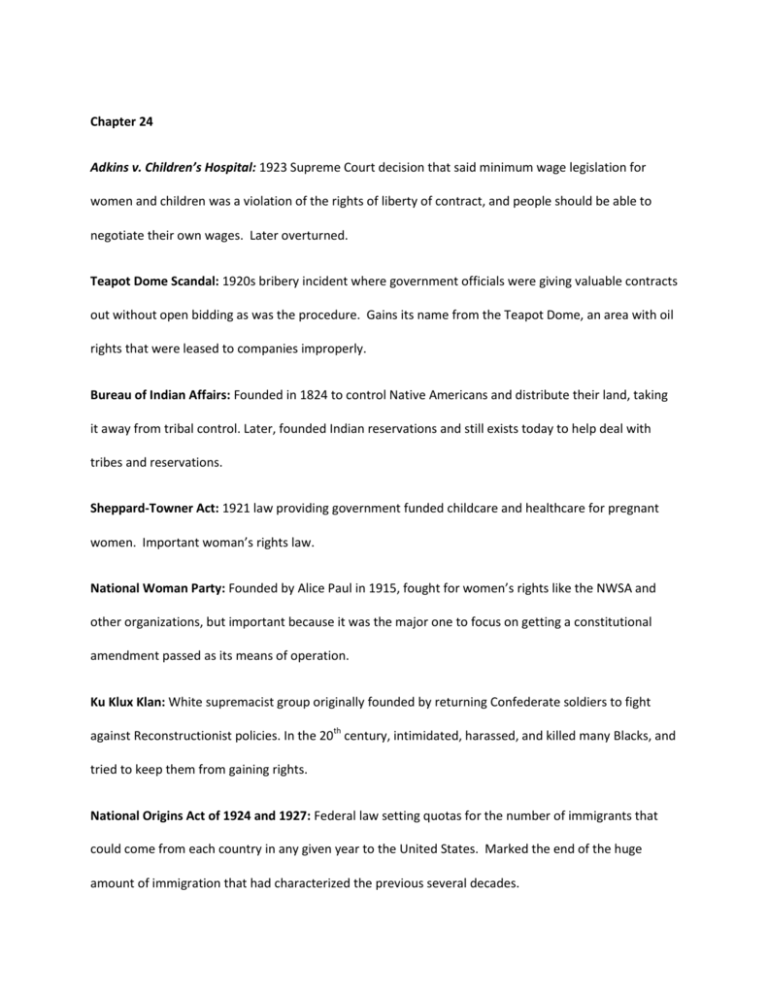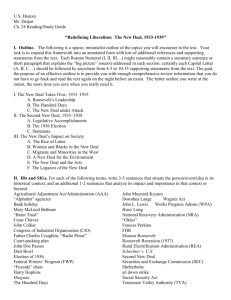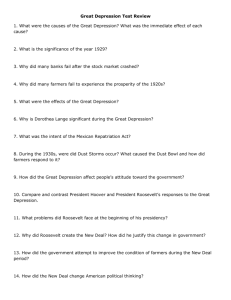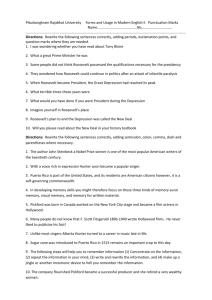Chapter 24 Adkins v. Children's Hospital: 1923 Supreme Court
advertisement

Chapter 24 Adkins v. Children’s Hospital: 1923 Supreme Court decision that said minimum wage legislation for women and children was a violation of the rights of liberty of contract, and people should be able to negotiate their own wages. Later overturned. Teapot Dome Scandal: 1920s bribery incident where government officials were giving valuable contracts out without open bidding as was the procedure. Gains its name from the Teapot Dome, an area with oil rights that were leased to companies improperly. Bureau of Indian Affairs: Founded in 1824 to control Native Americans and distribute their land, taking it away from tribal control. Later, founded Indian reservations and still exists today to help deal with tribes and reservations. Sheppard-Towner Act: 1921 law providing government funded childcare and healthcare for pregnant women. Important woman’s rights law. National Woman Party: Founded by Alice Paul in 1915, fought for women’s rights like the NWSA and other organizations, but important because it was the major one to focus on getting a constitutional amendment passed as its means of operation. Ku Klux Klan: White supremacist group originally founded by returning Confederate soldiers to fight against Reconstructionist policies. In the 20th century, intimidated, harassed, and killed many Blacks, and tried to keep them from gaining rights. National Origins Act of 1924 and 1927: Federal law setting quotas for the number of immigrants that could come from each country in any given year to the United States. Marked the end of the huge amount of immigration that had characterized the previous several decades. Scopes Trial: 1925 trial of a biology teacher who broke the law by teaching evolution: became about whether or not evolution was scientifically sound. Prosecuted by William Jennings Bryan, who ultimately won Prohibition: movement to prohibit drinking alcohol in the United States—constitutional amendment made alcohol illegal in much of the 1920s. Lost Generation: Generation that was of draft age during WWI. They are called “lost” because so many of the men were killed, and those who came back were often lost in the normal world after their wartime experiences. Harlem Renaissance: Flowering of culture and literature of African Americans, which took place in Harlem neighborhood of NYC in the 1920s and 1930s. Gave many important Black artists, etc. their fame. Charles A. Lindbergh: American aviator who was the first flier to cross the Atlantic in a plane, in 1927. He became a huge celebrity because of this feat, and was also famous because his baby was kidnapped for ransom later in his life. Warren G. Harding: 29th president of the United States, who presided over much of the “Roaring Twenties,” including the enactment of Prohibition. Charles Forbes: Director of the Veterans Bureau during the administration of Harding. Was extremely corrupt and caused a big scandal and angered the President. Harry Daughtry: One of Warren Harding’s advisors and his manager during his campaign for president. Later attorney general, but had to resign, like Forbes, due to corruption scandals. Calvin Coolidge: 30th president of the United States. Brought back the public’s confidence in government after the corruption of the Harding administration. Marcus Garvey: Noted Black activist and proponent of the Back to Africa movement, the idea that African-Americans should move back to their ancestral homeland rather than making lives in the USA, the land of their oppressors. Niccola Sacco and Bartolomeo Vanzetti: Italian immigrants, who were anarchists, convicted of a bombing in the 1920s and executed. Important because they became figureheads for the anarchist movement and America’s fear of anarchists that was part of the zeitgeist at the time. Al Capone: Chicago-area gangster who ran liquor during Prohibition. Important because he is one of the most notorious criminals of all time, and because his organization in Chicago represented the rise of organized crime. Herbert Hoover: 31st president—became president in 1929, which was the year the stock market crashed, sending America into the Great Depression. Did not handle the Depression well, and was widely reviled by citizens of Hoovervilles—shanties homeless people had to live in. Al Smith: Four time progressive governor of New York, who put many social reforms into place. Also the first Catholic candidate for president (in 1928). Dust Bowl: An era of serious dust storms from 1930 to 1936 that caused severe damage to agriculture in the prairie states. It came about because of a combination of a major drought and over-farming. “Hoovervilles”: Shantytowns built by homeless people during the Great Depression. Named for President Hoover, who was seen as having caused the Depression. Hawley-Smoot Tariff: A 1930 law that raised taxes on thousands of imported goods to nearly-unheard of levels. Some say the international backlash from these tariffs made the Great Depression worse. Reconstruction Finance Corporation: A federal agency founded in 1932 that gave over $2 billion in loans to state and local governments and railroads, banks, and other businesses. Was carried over into the New Deal and helped the country deal with the Great Depression. Bonus Expeditionary Force: A group of thousands of World War I veterans, their families, and allies who marched on Washington, DC in 1932. They were demanding that their benefits be given to them in cash immediately, instead of in 1945. Twentieth Amendment: This amendment set the official beginning and end date for the terms of the President and Vice President to be January 20th, instead of March 4th, to ensure that newly-elected Presidents would be able to deal with crises that happened between Election Day and when they would normally start their terms. Roosevelt’s fireside chats: These radio speeches were given by President Roosevelt in 1933 and 1934 as a way of making sure the nation understood what his policies were. He started doing speeches like these while he was Governor of New York. First Hundred Days: President Roosevelt made a point of getting as much done as he could as quickly as possible to deal with all of the serious problems that existed in the middle of the Great Depression when he took office in 1933. American Liberty League: This organization was founded by conservative Democrats in 1934 to fight against Roosevelt’s New Deal reforms. Once Roosevelt was re-elected by a huge margin in 1936, the ALL pretty much disappeared. Second New Deal: The second stage of Roosevelt’s New Deal reforms, from 1935-1936. Included Social Security, the Wagner Act, and the Banking Act, electricity in rural areas, the WPA, and the Resettlement Administration. New Deal coalition: A group of interest groups and voting blocs that started supporting Democrats during the New Deal era (1932), and didn't stop until the late 1960s. Dwight Eisenhower was the only Republican in that era to defeat this coalition of Democrats, big city machines, labor unions, minorities, farm groups, intellectuals, and white Southerners. Congress of Industrial Organizations: The CIO was formed in 1935 by eight industrial unions in the AFL who were trying to change AFL policy about organizing mass production workers. The AFL kicked them out in 1936, and they went on to be fierce and, at times, radical, advocates for industrial workers until they rejoined the AFL in 1955. Indian Reorganization Act: This 934 law gave Native Americans the rights to govern themselves and control their own lands that they had lost because of the Dawes Act. It also tried to put reservationdwellers on solid economic footing. NLRB v. Jones: This 1937 Supreme Court case upheld the Wagner Act as constitutional. It marked the end of the era of the Court declaring many parts of the New Deal unconstitutional and greatly expanded the power Congress was seen to have under the Commerce Clause of the Constitution. Herbert Hoover: The 31st President, he was in office from 1929-1933. An engineer who believed that problems in government and business were caused by inefficiency and could be solved by experts, he tried to fight the Great Depression with volunteer efforts that didn't work. Franklin D. Roosevelt: The 32nd President, he brought America out of the Great Depression and led the country through World War II. His New Deal programs of relief, recovery, and reform helped pull the country back from the brink of economic collapse. Father Charles Coughlin: He was an outspoken Catholic priest from Michigan who became a populist political leader through his charismatic radio sermons. He began as a strong backer of Roosevelt, but later turned vehemently against the President, claiming that Roosevelt was too easy on prominent bankers. Dr. Francis E. Townsend: A physician who’s “Townsend Plan” for pensions for old people was one of the major influences for FDR's Social Security program. He famously promoted his plan like a real estate salesman. Huey Long: A Governor and later a Senator from Louisiana in the late 1920s and 1930s, he was known for being a far-left populist who split with FDR in 1933. His “Share Our Wealth” program focused on high taxes on corporations and rich the rich in order to redistribute wealth to those most severely affected by the Depression. John L. Lewis: The leader of the United Mine Workers from 1920 to 1960, he helped found the Congress of Industrial Organizations. He was a major backer of FDR's domestic policies, but split from the President in 1940 because he didn't support an interventionist foreign policy. John Collier: A leading advocate for Native Americans, he was Commissioner of Indian Affairs from 1933 to 1945, after having helped bring attention to the need to reform the agency in the 1920s. As Commissioner, he helped implement New Deal reform and relief programs for Native Americans. Marian Anderson: A celebrated singer, she also became a central figure as blacks attempted to break into the mainstream of American pop culture. Fighting racial prejudice, she attracted prominent backers – including Franklin and Eleanor Roosevelt, and broke down many significant barriers. A. Philip Randolph: A major civil rights leader, he founded the Brotherhood of Sleeping Car Porters, a major development for the labor movement – particularly black labor organizing. In addition, beginning in 1941, he was a driving force behind the movement to have marches on Washington to protest for civil rights for African-Americans. Chapter 26 Washington Naval Conference: Disarmament treaty in the US in 1921-22, conducted by the League of Nations, mostly to keep Japan from getting too powerful. Led to several treaties (see next ID.) Five-Power Treaty, the Nine-Power Treaty, and the Four-Power Treaty: Treaties signed at the Washington Naval Conference meant to keep things as they were in the Pacific, with China a sovereign nation and each country not trying to expand territory. Kellogg-Briand Pact of 1928: 1928 treaty signed by many major nations, including the US and Japan, decrying war as a means of foreign policy—basically meant to be a worldwide peace treaty. Dawes Plan of 1924: An attempt to get war reparations (money for time, lives, etc. that were lost) from Germany after WWI. Was unsuccessful. Reciprocal Trade Agreements Act: 1934 law giving the president the right to negotiate trade deals with other countries. Began the trade policies that still persist as part of US foreign policy. Good Neighbor policy: Franklin Delano Roosevelt’s policy toward Latin America during his presidency. Basically, the idea was not interfering in any of the domestic affairs of these countries, in direct contrast with the Monroe Doctrine, which has been a previous policy that did the opposite. Nye Committee: Committee that studied how the USA got involved in World War I. Important because it influenced public opinion in favor of the idea that the country should not get involved in World War II, at least initially. Neutrality Acts of 1935, 1936, and 1937: Series of laws that put forth the US’s policy of isolationism. Important because they stopped the United States from getting involved in World War II as it had in World War I, at least until the advent of Pearl Harbor. Stimson Doctrine: 1932 policy denouncing Japan’s seizing of Manchuria and saying that the United States would not acknowledge lands taken by force as part of Pacific countries. Significant because it soured US-Japan relations, indirectly leading to Pearl Harbor. Lend-Lease Act: World War II-era program that allowed the United States to supply war materials, such as munitions and planes, to Allied countries as needed, leading to a profitable arrangement for the US. Chapter 27 Navajo Code Talkers: Bilingual Native Americans of the Navajo tribe trained in WWII. Their language was used as a radio code. War Production Board: Government agency founded in 1942 to make sure the US had enough war materials and to ration things like gasoline and rubber. Manhattan Project: Scientific experimentation taking place in New York (thus the name). Resulted in the development of the atomic bomb. Executive Order #8802: Signed by President Roosevelt in 1941 to outlaw racial discrimination in jobs that had to do with the war effort. Significant because it was the first non-discrimination effort by the federal government, even though it was not a law. Rosie the Riveter: Character in propaganda (“We Can Do It” poster still seen today) that represented women in the war effort. Significant because she represented the fact that women were taking over jobs traditionally held by men, such as factory work, during the war. National War Labor Board: Federal agency started during World War I (1918) to help laborers and bosses reach agreement in labor-related matters that had to do with the war effort. Re-established by Roosevelt during World War II. War Labor Disputes (Smith-Connally) Act: Law passed in 1943 in response to a strike that allowed the federal government to operate businesses in industries where war-related production might be threatened by a strike. Basically, took away workers rights to strike in these industries. Roosevelt tried to veto it. Office of Price Administration: Federal committee and group to prevent the rise of rents and prices after the outbreak of World War II. Zoot Suit Riots: Riots in 1943 involving Latinos and white Marines and Navy personnel. Triggered racially motivated attacks against Latinos in other places as well. Named for the suits some Latino young men wore. Korematsu v. US: 1944 Supreme Court decision that interring Japanese Americans in camps was constitutional rather than racial discrimination. Never explicitly overturned, although of course the camps were disbanded. 442nd Regimental Combat Team: Japanese American fighting unit of the Army that fought in Europe during World War II. Most decorated unit in the history of the American military. Congress of Racial Equality: Civil rights organization that believed in non-violent means to get the vote for African-Americans. Led March on Washington, sit-ins, etc. Tuskegee Airmen: Nickname of African-American fighting unit in World War II. Racial trailblazers who were subject to discrimination but rose above it. Yalta Conference: 1945 meeting to discuss how Europe should be organized after World War II, led by Roosevelt and British Prime Minister Winston Churchill. Potsdam Declaration: Agreement outlining Japan’s surrender terms at the end of World War II. Hiroshima and Nagasaki: Two Japanese cities. Important because they were the places where Truman chose to drop the atomic bomb. Harry S. Truman: 33rd president of the United States, who ended World War II by deciding to drop the atomic bomb on Hiroshima and Nagasaki.







